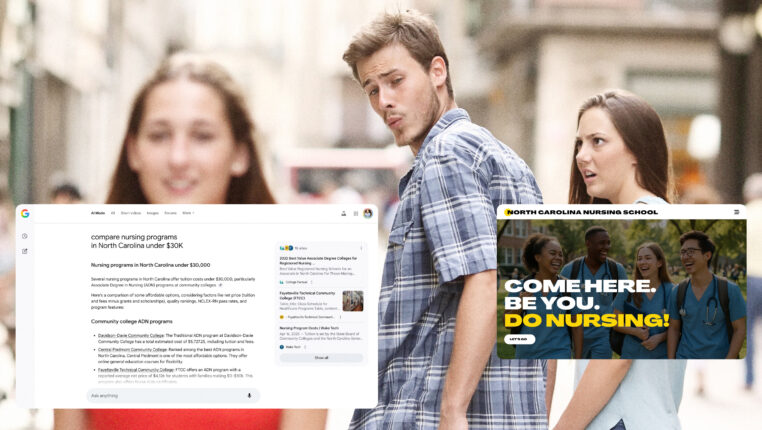One of the great things about building websites for colleges and universities is that we are always learning. And a big part of that learning comes from talking to people. As part of our user-focused work, we are constantly interviewing prospective students and their parents about their goals, their needs and their experiences. The information we learn from them is essential to the strategies and concepts that underpin the websites we design and build for our clients.
In the last two years we have met with more than 50 prospective college and university students of all ages, backgrounds and interests, from graduating high schoolers to adult learners interested in community colleges. We also spoke to more than 20 parents of prospective students.
And although the questions we asked varied based on the types of colleges and universities we were working with and what their needs and goals were, there were a few consistent themes that came up time and again among those we interviewed. These themes were broadly shared by students of all backgrounds and had major implications for how they evaluated which university or college to choose.
Here is what we have learned from those interviews, including the challenges facing colleges and universities, the perceptions — in their own words — of these students and parents, and how colleges and universities can successfully meet these students where they are.
1. Make a Great First Impression
The Challenge: Prospective college and university students have a lot vying for their attention. They are used to living in a high-paced digital world that has increasingly high levels of creativity and polish — and that puts users first as consumers and decision-makers.
In Their Words:
“What’s really shocking to me is sometimes my daughter just goes to the website and literally spends two minutes and then nope. ‘That’s not the school for me’ and that’s all she’s done” — Parent of a prospective student
“I just feel like a website kind of gives off a strong impression because that’s one of the first things that students are interacting with whenever they’re looking at community colleges. So, I feel like if you have a dated, you know, kind of old-looking website, it kind of gives off that impression that the school is also kind of old and not really good.”— First-year student at Community College
How to meet their needs: Your brand needs to be inspiring, exciting and modern as it needs to compete for their attention with so many other things. You need to stand out among the noise, the distractions and your real competitors. You need to make them believe they can achieve their dreams.
2. Show the Key Facts Right Away
The Challenge: Similarly to the power of first impressions, there are certain pieces of key information that prospective students want to see right away. We’ve heard loud and clear from future students and their parents: They need to see:
- Admission rates
- Financial aid information
- Available programs
- Application deadlines
- Location and online/flexible course offerings, particularly for community college students.
This is all critical information as prospective students and their families decide early on in their college search whether or not they are going to consider your university — and they want and expect all of this crucial information to be available within just one click from your homepage.
In Their Words:
“I just want to be able to quickly, find how much tuition is, and how many scholarships they offer. Or what are the courses of study? I mean, that’s probably the first thing I look up, like what courses of study that they have and if it checks those boxes.” — Prospective parent
How to meet their needs: So, let’s make it super easy for them! Be transparent and use this to your advantage. Put quick stats right on your homepage, create engaging posts for your social media, or even rename your menu options in the navigation bar to highlight these key details.
3. Meet Them Off-Platform
The Challenge: To first reach your prospective students online, you need to be where they are. And that’s not on your website (not yet, at least). They’re on Instagram, RateYourProfessor, CollegeRating, YouTube, Reddit, and other similar platforms. These digital channels are just as powerful as in-person events like a high school college fair for getting noticed.
In their words:
“Well honestly, I found out about the University of Alabama through social media. I had a friend whose older sister is now attending there, and she was posting things about it. So over spring break, I toured it. And I fell in love with it. A lot of colleges have Facebook groups or Instagram groups, or if you know somebody that attended you can always ask them. Yes, I visited most of the websites.” —Dual enrollment student
How to meet their needs: Start by being active on social media and the digital spaces your students frequent. It’s not enough to just have an account and post something boring once a month. You need to really be there. Stay engaged and engaging—update frequently, answer questions, collaborate with others, join the latest trends, and make them yours (even if it means getting your dean to do the latest viral TikTok dance).
Then go deeper by seeing how your school shows up on third-party ratings and review platforms, and be ready to hop into the comments to clear up any confusion or to react to negative comments. If you’re not prepared to do that, you should at least be monitoring these sites so that you can reach out to them if they have information listed about your institutions that is incorrect or out of date.
4. Simplify Your RFI and Contact Forms
The Challenge: When students and parents land on your website, they’re not ready to reach out right away—they want to learn more about you first.
Think of it like dating: you wouldn’t ask about having kids on the first date. So, don’t ask for too much info before starting a one-on-one chat.
In their words:
“It was hard when forms and stuff were difficult to fill when trying to apply to a school or program. I had to have my advisor email them to me, when I wanted to prove I was employed for financial aid. This slowed down the process.” — High school student
How to meet their needs: Asking for too much info upfront can feel overwhelming and intrusive, so your first step is to get just enough details to keep the conversation going without making them feel like they’re committing right away. In your top-of-funnel RFIs, ask for the basic contact information and leave out the granular, personal details like mailing address, birthday, household income, etc. Make the contact and leave it at that until the relationship has matured.
5. Use AI Tools to Answer Common Questions
The Challenge: Today’s prospective students are growing up with AI; they’re probably using AI for creating their college essays and most of their homework, too. They are using it and you should too, but maybe not for the same goals.
Prospective students and parents tend to prefer to have a phone conversation instead of filling up forms or even sending emails because they are able to ask further questions for clarification or for more related information and have second chances to ask questions they may not think about first.
In their words:
“I kind of like over the phone a little bit better because I think it’s easier to communicate what you’re trying to say than in email. Sometimes, I’ll leave out a sentence that I meant to say and then I’m like, Oh no, I forgot to mention that. So I feel like over the phone it’s also easier to just get a response really quickly.” — Prospective student
How to meet their needs: You can use AI to make your website search functionality much more engaging where they can ask questions in a more natural way and you can provide more than just a list of links to your website pages. AI can be used as a bot for virtual campus tours or for creating a personalized brochure of the key things they value about your campus.
And we know it works. One of our client’s, Forsyth Community College, saw a 25% reduction in student care phone calls and a 10% increase in enrollment after implementing AI bots on their site.
The possibilities are limitless and if you are transparent about the use of it, you could even make yourself cooler and stand out from your competitors.
How to Get Those Prospective Students and Parents to Talk to You
One question our clients ask us about our audience research: How will we get in touch with prospective students to speak to them, in the first place? Full disclosure: It’s not easy! But with our experience and the right tools, we have been able to talk with those prospective students and parents and get their thoughts and experiences.
We have used current website pop-ups, mailing lists from high schools and college fairs, social media campaigns and even partnering with market research recruitment agencies for identifying and arranging the interviews, usually involving some kind of incentive like an Amazon or a College Merchandise voucher. With the right targeting and a bit of persistence, we’re always able to entice enough potential users to engage with us.
The Value of Partnerships
Of course, these are just a few of the many insights we’ve received from our conversations with students and parents when they are looking to start their education journey after high school.
We deeply value our partnerships with higher education institutions, and continue to learn even more about today’s student body.
Want to learn more about a higher education partnership and how to leverage our expertise? Reach out to us!



